INTRODUCTION
The Indian Himalayan Region is known as a mega-biodiversity hotspot that covers over 18% of the Indian sub-continent (Myers, 2006; Radha etet alal., 2019a, 2020). Since ancient times, the area has been well known for its rich ethnomedicinal flora (Vidyarthi et al., 2013). The abundance of plant diversity in the region is due to the presence of different biogeographic regions (Samant and Dhar, 1997; Radha et al., 2019b). The main reasons for the decline in the population of medicinal plant availability in the Himalayan region were excessively caused by the pressures of human activity. With growing demand and renewed global interest in traditional ethnopharmacy, combined with the increasing preference in the healthcare system for natural substances, the natural stock of medicinal plant species in Himachal Pradesh is under great pressure (Chauhan, 2003; Radha et al., 2019a).
Since ancient times, indigenous communities have depended primarily on indigenous plants for their daily needs, such as fuel, food, food, and medicines. Documentation of traditional knowledge has provided a variety of essential medicines for the modern world and this information also can be used for the conservation and sustainable use of medicinal plants (Fabricant and Farnsworth, 2001; Rahman et al., 2004). Traditional knowledge of medicinal plants is in decline in many areas, as the new generation is having little interest in learning traditional knowledge (Kargioglu et al., 2008; Radha and Puri, 2019a, 2019b, 2019c). For the conservation and utilization of biological wealth, proper documentation of traditional knowledge is, therefore, necessary (Muthu et al., 2006).
The study area, Nargu Wildlife Sanctuary located in the Mandi district of Himachal Pradesh, harbors a rich assortment of medicinal plants in its sanctuary area (Sharma et al., 2015). In earlier studies, it was reported that the Mandi district is well recognized for its ethnobotanical plant diversity in the Western Himalayan region (Sharma et al., 2013). This present study aims to document the traditional knowledge of medicinal plants used by the local people of the Nargu Wildlife Sanctuary and encourages the preservation of this previously undocumented information for future generations.
MATERIALS AND METHODS
Study area
The study was undertaken in the Nargu Wildlife Sanctuary of district Mandi in Himachal Pradesh, India (Fig. 1). Mandi district of Himachal Pradesh supports three Wildlife Sanctuaries (viz. Bandli, Nargu, and Shikari Devi) (Sharma et al., 2013). The Nargu Wildlife Sanctuary (31°046′N to 32°05′N latitudes and 76°50′–77°04′ E longitudes) is situated in Mandi district of Himachal Pradesh, India (Fig. 1). The temperature varies from −10° to 35°C and the average annual precipitation is 1,400 mm. It was stated in earlier studies that the sanctuary region is rich in biodiversity (Sharma et al., 2017). The whole region is primarily mountainous with low hills undulating in the west and steep in the northeast to precipitous mountains. There are many elevated ridges, deep cliffs and gorges, and small valleys. The weather is temperate, subtropical, alpine, and sub-alpine in the study section. Around 80% of the rainfall is normally caused by the southwestern monsoon and the remainder by western storms (Sharma et al., 2017).
Data collection
The study on the ethnobotanical evaluation of indigenous plants of the Nargu Wildlife Sanctuary of district Mandi was carried out from 2019 to 2020. Extensive field visits were carried out in the Nargu Wildlife Sanctuary. Ethnobotanical data were collected through common discussions with the local informers aged between 20 and 70 years (Table 2). Most of the respondentset alwere aged over 60 years (34%) It was found that males were more affable to participate in conversations than females. A total of 73 males were questioned to collect ethnomedicinal data which were selected using purposive sampling technique based on the recommendations of knowledgeable elders and their reputation in the area for their knowledge about herbal medicines and the traditional healthcare system. A questionnaire was developed and pre-tested prior to the survey with informants in order to assess its suitability for the current study and updated according to the informant’s response. The revised questionnaire was used for the collection of data about medicinal plants from the local people of Nargu Wildlife Sanctuary. The field survey was carried out with local people as guides and voucher specimens of the medicinal plants were collected and their local identity was verified by other informants. The information obtained was cross-checked with the other informants from this area. The information about local names, habits, parts used, routes of administration, traditional medicinal uses of plants were carefully recorded. The collected plant specimens were identified from Botanical Survey of India Dehradun Uttarakhand and identified plant specimens with voucher numbers were submitted in the herbarium of Shoolini University, Solan, Himachal Pradesh, India.
RESULTS AND DISCUSSION
The present study’s results showed that local people of this area have strong traditional knowledge of valuable wild medicinal plants. During interactions with local people of the sanctuary area, it was observed that the traditional knowledge of wild medicinal plants was acquired by them through experience and from their elders. A total of 45 wild ethnomedicinal plants, belonging to 28 different families were identified (Fig. 4). Of the identified species, most were herbs and shrubs (36%); followed by trees (13%), climbers (11%), and ferns (4%) (Fig. 2). Detailed information regarding their botanical name, vernacular name, name of the family, part used for the ailment, etc. are presented in Table 1.
The plants documented foret althe ethnomedicinal values belong to families Acanthaceae, Amaranthaceae, Asparagaceae, Aspleniaceae, Asteraceae, Berberidaceae, Buxaceae, Dryopteridaceae, Ericaceae, Fabaceae, Lamiaceae, Oxalidaceae, Poaceae, Pinaceae, Polygonaceae, Primulaceae, Rosaceae, Ranunculaceae, Rubiaceae, Salicaceae, Sapindaceae, Saxifragaceae, Scrophulariaceae, Thymelaceae, Urticaceae, Violaceae, and Vitaceae. The Rosaceae family contributed the highest number of medicinal plants (7) used by local people, followed by Polygonaceae and Asteraceae (4).
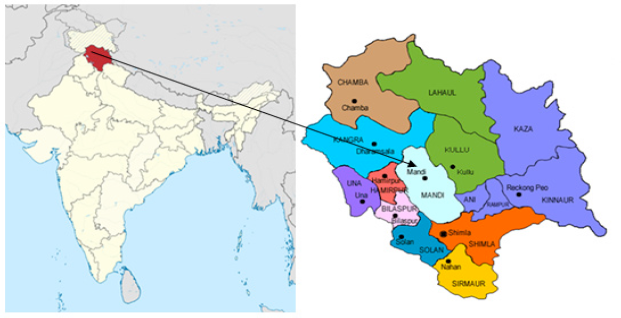 | Figure 1. Location of the study area. [Click here to view] |
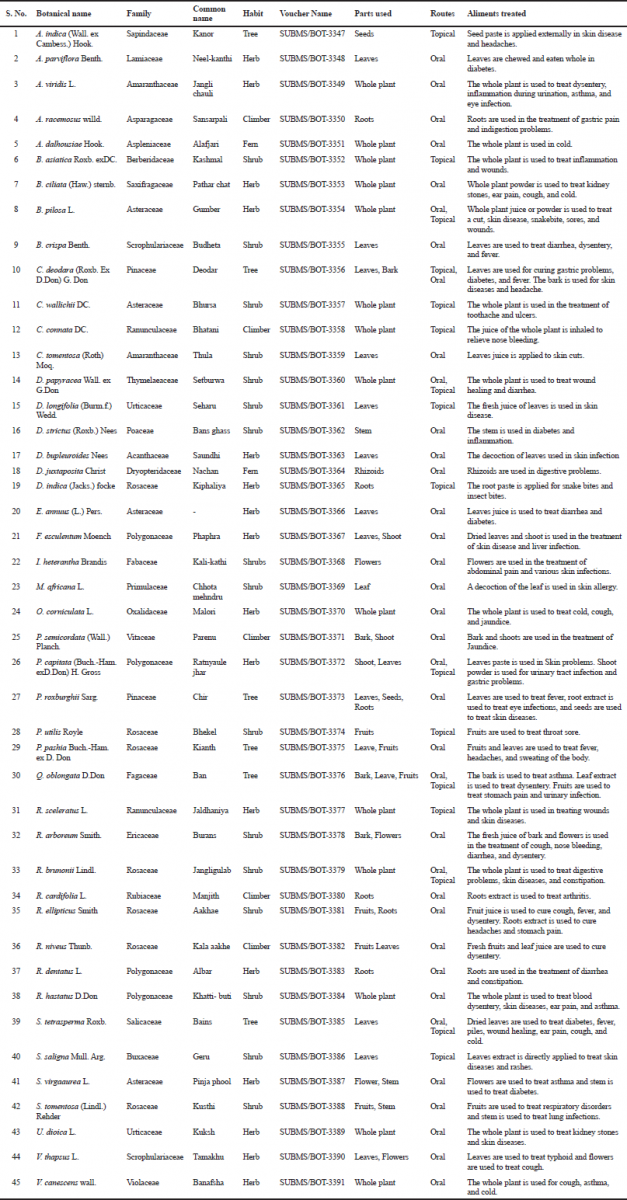 | Table 1. Wild ethnomedicinal plants used in Nargu Wildlife Sanctuary of Himachal Pradesh, India. [Click here to view] |
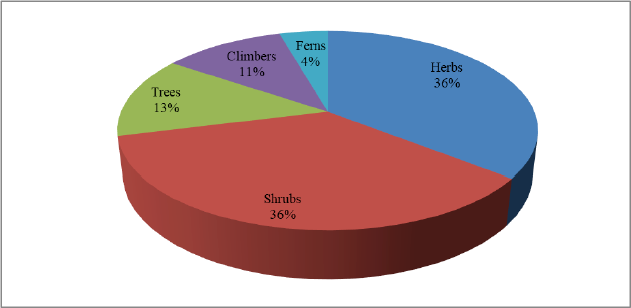 | Figure 2. Category of ethnomedicinal plants used in study area. [Click here to view] |
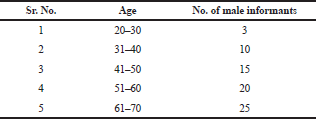 | Table 2. Ethnomedicinal data collected from different groups. [Click here to view] |
In the Nargu Wildlife Sanctuary the most commonly reported diseases were skin infection, dysentery, cough, fever, wound healing, diabetes, and cold. All the plants belonging to the Rosaceae family were used for skin diseases, fever, and dysentery. The plant species Ajuga parviflora, Asparagus racemosus, Berberis asiatica, Bergenia ciliata, Bidens pilosa, Cedrus deodara, Cirsium wallichii, Fagopyrum esculentum, Oxalis corniculata, Pinus roxburghii, Pyrus pashia, Quercus oblongata, Rhododendron arboreum, Rubus ellipticus, Rubus niveus, Rumex dentatus, and Urtica dioica were commonly used in the sanctuary area. The plant species reported by local people for the treatment of skin infection were Aesculus indica, Debregeasia longifolia, Dicliptera bupleuroides, F. esculentum, Indigofera heterantha, Persicaria capitata, P. roxburghii, Ranunculus sceleratus, Rosa brunonii, Rumex hastatus, Sarcococca saligna, and U. dioica; for dysentery: Amaranthus viridis, Q. oblongata, R. arboreum, R. ellipticus, and R. hastatus; for cough: B. ciliata, O. corniculata, R. arboreum, R. ellipticus, Salix tetrasperma, Verbascum thapsus, and Viola canescens; for fever: C. deodara, Daphne papyraceae, P. roxburghii, R. ellipticus, R. ellipticus, and P. pashia; for wound healing: B. asiatica, B. pilosa, Cyathula tomentosa, D. papyracea, R. sceleratus, and S. tetrasperma; for diabetes: A. parviflora, C. deodara, Dendrocalamus strictus, Erigeron annuus, S. tetrasperma, and Solidago virgaaurea; for cold: Asplenium dalhousiae, B. ciliata, O. corniculata, S. tetrasperma, and V. canescens.
The most commonly used parts of the plants were leaves, followed by whole plant and roots (Fig. 3). Leaves were reported as the most widely used parts of medicinal plants. It was observed that few plants were used as whole plants for the treatment of various diseases by the local people and these were A. viridis, A. dalhousiae, B. asiatica, B. ciliata, B. pilosa, C. wallichii, Clematis connata, D. papyracea, O. corniculata, R. sceleratus, R. brunonii, R. hastatus, U. dioica, and V. canescens. Local people of the sanctuary area reported that the paste of fresh leaves Persicaria capitita were applied on the skin for curing skin diseases. The rhizomes of Dryopteris juxtaposita are used for curing digestive problems. Dried leaves of F. esculentum were used to cure skin diseases and liver disorders. The juice of the C. connata is used for nose bleeding; C. tomentosa leaf juice is applied on skin cuts; D. longifolia leaf juice is used for skin diseases; E. annuus leaf juice is used in diarrhea and diabetes; R. ellipticus fruits juice is used for the treatment of cough, dysentery, and cold; Rubus nivis fruit and leaf juice is used to cure dysentery.
Few plant species were used as fodder for livestock, such as A. indica, A. parviflora, A. viridis, A. racemosus, A. dalhousiae, B. asiatica, B. ciliata, B. pilosa, Buddleja crispa, C. deodara, C. wallichii, C. connata, C. tomentosa, D. papyracea, D. longifolia, D. strictus, D. bupleuroides, D. juxtaposita, Duchesnea indica, E. annuus, I. heterantha, Myrsine africana, Q. oblongata, R. sceleratus, R. arboreum, R. brunonii, R. ellipticus, R. dentatus, U. dioica, V. thapsus, and V. canescens.
The present study foundet althat few plant species are used as wild edibles plants such as B. ciliata leaves and fruits are edible, Berberis aristata and R. ellipticus fruits are edible; R. hastatus leaves are used as sallet; R. arboreum fruits are edible and U. dioica leaves are cooked as a wild vegetable. In addition to their medicinal importance, certain plant species are of religious and cultural importance for the local people. A. racemosus and O. corniculata are highly used by the native people of the study area both for medicinal properties and cultural significance. Some of the wild ethnomedicinal plants were also used as timber wood such as A. indica, C. deodara, P. roxburghii, and Q. oblongata.
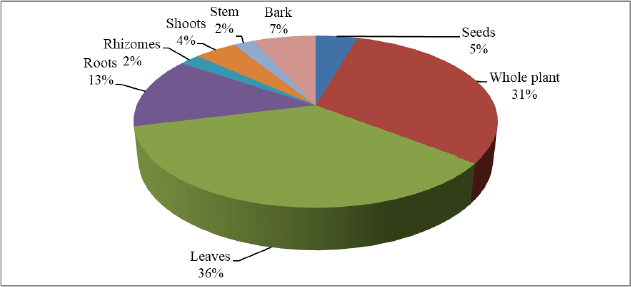 | Figure 3. Plant parts used in study area. [Click here to view] |
 | Figure 4. Ethnomedicinal plants used in Nargu Wildlife Sanctuary of district Mandi in Himachal Pradesh. [Click here to view] |
The data produced from the study on the medicinal plants used by the native people need comprehensive phytochemical research including with few clinical studies which might help to create awareness programs of the preservation, promotion, traditional knowledge of ethno-medico-botany in the study area. There is also a serious need for the development of conservation repositories like herbal gardens, nurseries, and inspiring farmers to cultivate endangered medicinal plant species of the state.
CONCLUSION
The Himalayas has an amazing assortment of plant species due to its unique location and has been considered as a treasure that is confined to societies living here, but this wealth is diminishing fast because societies residing in this belt hesitate to share their information with others. The ethnobotanical study conducted in Nargu Wildlife Sanctuary of district Mandi revealed that native people of the sanctuary area have faith and respect for traditional medicines. Forty-five medicinal plants belonging to different families were reported from the study area including common name, ailments treated, parts used, and mode of administration. The findings indicated that the nativeset alof Himachal Pradesh, especially those residing in remote and high-altitude areas, are mainly dependent on the surrounding plant resources to meet their daily requirements. The information collected from the local inhabitants of the Nargu Wildlife Sanctuary indicates that study area is rich in wild ethnomedicinal plants, and the results contribute to spreading their uses. The social significance of wild medicinal plants in the community is very important for public health and thus more attention needs to be paid to research on these traditional medicinal plant species in an effort to improve human health that can be applied more effectively in geographical areas that lack access to good healthcare facilities.
ACKNOWLEDGMENTS
We would like to sincerely thank the local inhabitants of Nargu Wildlife Sanctuary for sharing their traditional ethnomedicinal information.
AUTHOR CONTRIBUTIONS
All authors made substantial contributions to conception and design, acquisition of data, or analysis and interpretation of data; took part in drafting the article or revising it critically for important intellectual content; agreed to submit to the current journal; gave final approval of the version to be published; and agree to be accountable for all aspects of the work. All the authors are eligible to be an author as per the international committee of medical journal editors (ICMJE) requirements/guidelines.
FUNDING
There is no funding to report.
CONFLICTS OF INTEREST
The authors report no financial or any other conflicts of interest in this work.
ETHICAL APPROVALS
Not applicable.
PUBLISHER’S NOTE
This journal remains neutral with regard to jurisdictional claims in published institutional affiliation.
REFERENCES
Chauhan NS. Important medicinal and aromatic plants of Himachal Pradesh. Indian Forester, 2003; 129(8):979–98
Fabricant DS, Farnsworth NR. The value of plants used in traditional medicine for drug discovery. Enviro Health Perspect, 2001; 109(1):69–75. CrossRef
Kargıoglu M, Cenkci S, Serteser A, Evliyaoglu N, Konuk M, Kok MS, Bagci Y. An ethnobotanical survey of inner-West Anatolia, Turkey. Hum Ecol, 2008; 36(5):763–77. CrossRef
Kumar K, Parida M, Katiyar VK. Short term traffic flow prediction for a non urban highway using artificial neural network. Procedia Soc Behav Sci, 2016; 104(2):755–64. CrossRef
Muthu C, Ayyanar M, Raja N, Ignacimuthu S. Medicinal plants used by traditional healers in Kancheepuram District of Tamil Nadu, India. J Ethnobiol Ethnomed, 2006; 2(1):1–10. CrossRef
Myers N, Mittermeier RA, Mittermeier CG, Da Fonseca GA, Kent J. Biodiversity hotspots for conservation priorities. Nature, 2006; 403(6772):853–8. CrossRef
Radha, Janjua S, Srivastava S, Negi S. Ethnobotanical study of medicinal plants used in Shikari Devi Wildlife Sanctuary of Himachal Pradesh, India. Med Plants, 2020; 12(4):483–90. CrossRef
Radha, Puri S, Chandel K, Pundir A, Thakur MS, Chauhan B, Simer K, Dhiman N, Shivani, Thakur YS, Kumar S. Diversity of ethnomedicinal plants in Churdhar Wildlife sanctuary of district Sirmour of Himachal Pradesh, India. J Appl Pharm Sci, 2019; 9(11):048–53. CrossRef
Radha, Puri S, Kumar V. Phytochemical screening of medicinal plants used by tribal migratory shepherds in Western Himalaya. Ann Biol, 2019; 35(1):11–4.
Radha, Puri S. Assessment of wild medicinal plant used by migratory shepherds in alpine area of Rakchham-Chitkul Wild life Sanctuary of district Kinnaur in Himachal Pradesh. Plant Arch, 2019; 19(1):418–29.
Radha, Puri S. Phytochemical analysis of ethanolic extracts of leaves of some selected medicinal plants used by tribal community of Sangla valley, District Kinnaur, Himachal Pradesh. Plant Arch, 2019; 19(1):397–403.
Radha, Puri S. Survey of ethnomedicinal plants used by migratory shepherd’s in Shimla district of Himachal Pradesh. Plant Arch, 2019; 19(1):477–82.
Rahman MA, Mossa JS, Al-Said MS, Al-Yahya MA. Medicinal plant diversity in the flora of Saudi Arabia 1: a report on seven plant families. Fitoterapia, 2004; 75(2):149–61. CrossRef
Rani JV, Kanakaiah V, Dadmal T, Rao MS, Bhavanarushi S. Fluorinated natural graphite cathode for rechargeable ionic liquidbased aluminum–ion battery. J Electrochem Soc, 2013; 160(10):1781. CrossRef
Samant AV, Wei XL, Pirouz P. An optical and transmission electron microscopy study of deformation-induced defects in 6H-SiC. Philos Mag A, 1998; 78(3):737–46. CrossRef
Samant SS, Dhar U. Diversity, endemism and economic potential of wild edible plants of Indian Himalaya. Int J Sustain Dev World Ecol, 1997; 4(3):179–91. CrossRef
Samant SS, Gopal A. University of Florida Research Foundation Inc, Method and apparatus for x-ray radiographic imaging. U.S. Pat, 2014; 8:842, 809.
Sharma P, Agnihotry A, Sharma PP, Sharma L. Wild edibles of Murari Devi and surrounding areas in Mandi district of Himachal Pradesh, India. Int J Biodivers Conserv, 2013; 30(9):592–604.
Sharma P, Samant SS, Tewari LM, Rana MS. Diversity, distribution and conservation of orchids in Nargu Wildlife Sanctuary, NorthWest Himalaya. J Orchid Soc India, 2015; 29:15–21.
Sharma P, Saman SS, Lal M. Assessment of plant diversity for threat elements: a case study of Nargu wildlife sanctuary, north western Himalaya. Ceylon J Sci, 2017; 46(1):441. CrossRef
Vidyarthi S, Samant SS, Sharma P. Traditional and indigenous uses of medicinal plants by local residents in Himachal Pradesh, North Western Himalaya, India. Int J Biodivers Sci Ecosyst Ser Manag, 2013: 9(3):185–200. CrossRef